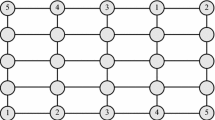Abstract
We address the Fleet Quickest Routing Problem (FQRP) on a grid graph, i.e. the problem of finding the paths \( n \) vehicles have to perform to reach their destinations by moving from the lowest to the highest level (row) of a grid, respecting capacity constraints on the arcs and nodes in the shortest time possible. Traversing an arc of the grid graph takes one unit of time: in this way, a solution is optimal if a vehicle travels along one of the shortest paths it can find from its starting node to its destination without stopping, meeting the capacity constraints we mentioned above. Such a path is made of both horizontal and vertical steps, from the lowest to the highest level of the grid, without cycles. The existence of such a solution is guaranteed by a sufficient number of levels. If this not being, an optimal solution could require stopping vehicles somewhere or making them travel on a non-shortest path. In a previous work, it has been proved that \( m^{ *} \) levels, where \( m^{ *} \) is an increasing function of \( n \), are sufficient to solve FQRP on grid graphs, when each vehicle performs all the horizontal steps of its path, if any, on one and only one level. The main contribution of this paper is the proof that, relaxing this property, the number of levels needed to guarantee a feasible and optimal solution is constant, i.e. it is 8. Whatever the number of vehicles, in a grid graph \( (8 \times n) \) it is always possible to find \( n \) shortest paths, one for each vehicle, which do not create conflicts and route every vehicle to its destination. Moreover, a routing rule that allows finding the solution to FQRP in every \( 8 \times n \) grid graph, whatever the destinations of the vehicles are, is provided. Practical relevance of FQRP mainly concerns the routing of Automated Guided Vehicles as well as the routing of aircrafts in airports.
Similar content being viewed by others
References
Aggarwal A, Kleinberg J, Williamson DP, Chuzhoy J, Kim DHK, Li S (2000) Node-disjoint paths on the mesh and a new trade-off in VLSI layout. SIAM J Comput 29(4):1321–1333
Andreatta G, De Giovanni L, Salmaso G (2010) Fleet quickest routing on grids: a polynomial algorithm. Int J Pure Appl Math 62(4):419–432
Balakrishnan H, Jung Y (2007) A framework for coordinated surface operations planning at Dallas-Fort Worth International Airport. In: AIAA guidance, navigation and control conference and exhibit, guidance, navigation, and control and co-located conferences. American Institute of Aeronautics and Astronautics, Reston, Virigina, pp 2382–2400. Available from: http://arc.aiaa.org/doi/pdf/10.2514/6.2007-6553. Accessed 15 Jan 2016
Cenci M, Di Giacomo M, Mason F (2017) A note on a mixed routing and scheduling problem on a grid graph. J Oper Res Soc 68:1363–1376
Chuzhoy J, Kim DHK (2015) On approximating node-disjoint paths in grids. In: LIPIcs-Leibniz International Proceedings in Informatics, pp 187–211
Chuzhoy J, Kim DHK, Nimavat R (2018) Improved approximation for node-disjoint paths in grids with sources on the boundary. http://arxiv.org/abs/1805.09956. Accessed 9 Apr 2019
Clare G, Richards A (2011) Optimization of taxiway routing and runway scheduling. IEEE Trans Intell Transp Syst 12(4):1000–1013. http://ieeexplore.ieee.org/xpls/abs_all.jsp?arnumber=5752242. Accessed 15 Jan 2016
De IPZ, Cutler M, Shiloach Y (1978) Permutation layout. Networks 8(3):253–278
Garcia J, Berlanga A, Molina J, Casar J (2005) Optimization of airport ground operations integrating genetic and dynamic flow management algorithms. AI Commun 18(2):143–164. http://www.researchgate.net/profile/Jose_Molina5/publication/220308927_Optimization_of_airport_ground_operations_integrating_genetic_and_dynamic_flow_management_algorithms/links/0912f509267636ce70000000.pdf. Accessed 15 Jan 2016
Gupta G, Malik W, Jung Y (2009) A mixed integer linear program for airport departure scheduling. In: 9th AIAA aviation technology, integration, and operations conference (ATIO), pp 21–23. http://arc.aiaa.org/doi/pdf/10.2514/6.2009-6933. Accessed 15 Jan 2016
Marín ÁG, Marin A (2006) Airport management: taxi planning. Ann Oper Res 143(1):191–202. http://link.springer.com/article/10.1007/s10479-006-7381-2. Accessed 15 Jan 2016
Pesic B, Durand N, Alliot J (2001) Aircraft ground traffic optimisation using a genetic algorithm. GECCO 2001. https://hal-enac.archives-ouvertes.fr/hal-00938003/. Accessed 15 Jan 2016
Roling PC, Visser HGH (2008) Optimal airport surface traffic planning using mixed-integer linear programming. Int J Aerosp Eng 2008(1):1–11. http://dl.acm.org/citation.cfm?id=1648386. Accessed 15 Jan 2016
Smeltink JW, Soomer MJ (2005) An optimisation model for airport taxi scheduling. In: Proc. 13th Conf. Math. Oper. Res., Citeseer, pp 1–25. http://citeseerx.ist.psu.edu/viewdoc/download?doi=10.1.1.116.9774&rep=rep1&type=pdf
Author information
Authors and Affiliations
Corresponding author
Additional information
Publisher’s Note
Springer Nature remains neutral with regard to jurisdictional claims in published maps and institutional affiliations.
Rights and permissions
About this article
Cite this article
Di Giacomo, M., Mason, F. & Cenci, M. A note on solving the Fleet Quickest Routing Problem on a grid graph. Cent Eur J Oper Res 28, 1069–1090 (2020). https://doi.org/10.1007/s10100-019-00620-5
Published:
Issue Date:
DOI: https://doi.org/10.1007/s10100-019-00620-5




